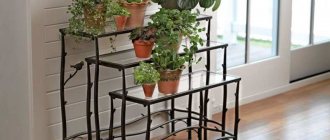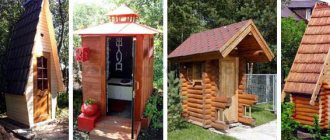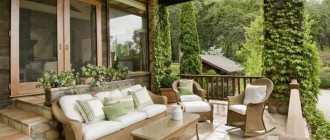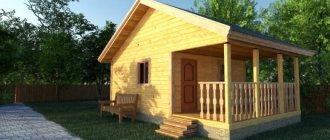The combination of a garden rose with other ornamental plants allows you to emphasize the beauty of this flower and divert attention from its possible shortcomings. A properly selected neighborhood will help you create a rose garden that will delight you with a riot of colors from spring until late autumn. Roses growing next to other flowers bloom longer and retain their decorative appearance. Cultivated plants adjacent to the queen of flowers protect her from weeds and sharp gusts of wind, creating a favorable microclimate. When wondering what flowers can be planted next to roses, select companions both in the same color scheme and in contrasting options.
All about creating a flower bed with roses at your summer cottage:
Making a beautiful rose bed suitable for your site with your own hands is not so easy. These exquisite flowers are capricious and do not go well with every plant. And for them to show themselves in all their glory, you will have to wait more than one season until the bushes grow. But the result will be worth the effort if done correctly. The first step is to find a corner on the site into which the new residents of the garden will fit.
Helpful partners
In addition to creating a certain decorative effect, companion roses can provide additional benefits. For example, ground cover plants not only successfully shade rose bushes, but also cover the soil, protecting it from drying out and suppressing weeds. You can use for example:
- coin loosestrife;
- thyme;
- survivors;
- periwinkles;
- ground cover species of sedums.
Many aromatic plants that successfully repel pests are also useful:
- lavender;
- thyme, or thyme;
- various types of mint;
- catnip;
- tansy;
- yarrow.
As you can see, choosing partners for roses is not such a difficult task as it might seem at first glance, because the choice is huge, you can find suitable options to solve any problem and implement the most unexpected ideas. Create your own unique rose garden!
Selection and preparation of a landing site
First, let's clarify the definition of a flower bed. Many novice gardeners confuse it with a flower garden. And although these are similar concepts, it is worth distinguishing between them.
A flowerbed can be part of a flower garden. This is a small (usually) area located on an embankment. It is distinguished by its geometric shape and clear boundaries.
It is precisely this landscape object that we will talk about in the article. You can arrange it as follows.
- At the wall of the house. It will to some extent protect the bushes from wind and frost. To make plants feel comfortable, maintain a distance of 50-60 cm between them and the building.
- At the fence. Such hedges are very beautiful, but you need to make sure that the seedlings are not in the shade and are planted at a distance of half a meter from the building.
- Along the edges of the garden path. This planting scheme looks impressive and at the same time ensures favorable conditions for the flower.
- Near the swing, bench, gazebo. The seating area is an excellent place for a picturesque flower bed.
In fact, you can make a bed in any corner of the site. The main thing is that it is well lit. This is one of the main requirements. But there are varieties that can be grown in partial shade and in low light. Looking ahead a little, we list their names.
- Tequila (Floribunda).
- Veilchenblau ("Floribunda").
- Mary Magdalene (David Austen).
- Gebruder Grimm ("Floribunda").
Musk hybrids, polyanthus and Rugosa hybrids, Gallic, Damascus, and Portland varieties are suitable.
Partial shade - 3-4 hours a day the area is in direct sunlight, in the morning and evening there is side lighting. Sparse lighting - light hits the object through a fence mesh, tree crown, etc. It is better if the plantings are protected from strong winds. In this regard, the location of any building is much more advantageous than an open area. The eastern part of the dacha is considered the ideal side.
Combine by similarity
The most important thing that every gardener should understand is that only a flower garden where the plants are healthy and well-groomed is beautiful. And this will be difficult to achieve if the requirements of the crops chosen for planting are not taken into account. Hence the first rule: combine only those plants that require similar conditions and agricultural technology.
So, combining hostas with roses may not be very successful (the former love shade, while the latter need good lighting). If you do want to include hostas in your arrangement, choose varieties that tolerate sunlight well, or place them so that the rose bushes cast a shadow on the leaves of the hostas.
Or, for example, decorative wormwood - its silvery shades combine perfectly with delicate roses, so flower growers often combine these plants in one composition. But unlike roses, many wormwoods prefer dry, poor soils, and living together for these crops is unlikely to be comfortable - perhaps it would be better to choose other plants with silvery foliage, for example, woolly chlorine or seaside cineraria.
Plants susceptible to the same diseases as roses will also require special attention. For example, varieties that are poorly resistant to powdery mildew should not be combined with phlox or mantle.
Soil composition for the garden bed
When the time comes for planting, you need to ensure good drainage if the groundwater is closer than two meters from the surface. To do this, remove 70 cm of soil, pour gravel into the trench and return the soil back.
Seedlings love fertile, moisture- and breathable soils. If the soil is initially heavy and dense, peat or sand is added to it. You can make the following composition:
- Peat mixture (2 buckets).
- Compost (2 buckets).
- Loam (1 bucket).
- Sand (5 liters).
- Vermiculite (5 liters).
Requirements for placement of seedlings
If you are setting up a classic rose garden, you will need a large garden plot. On an area of 15 m² you can place up to 25 large bushes. Among the good places for placing rose bushes, in addition to the main entrance, there is a slope on the south side, made in the form of terraces. For a decorative effect, make four to five tiers. Ground cover and climbing varieties can be grown in terraced rose gardens.
The area for planting seedlings should be well lit and protected from strong gusts of wind and drafts.
You should not plant rose bushes near fences or under trees with a dense spreading crown. When planting seedlings, it is necessary to avoid those places that are flooded with melt and groundwater in the spring. Places that are too dry should not be allowed. Flowers do not like drought as well as waterlogging.
It is better for plants when the soil is drained, fertile and moderately acidic. Fertilizers include rotted chicken manure, ash, river sand, peat and leaf compost. When organizing a rose garden, you need to focus on the condition of the soil. For light sandy soil you will need a weathered clay additive. It is often replaced with turf soil. The design of a flower garden of rose bushes must be approached responsibly. In order for the rose garden to live up to expectations, you will need to work hard and put in a lot of effort in the first years.
Selection of varieties and shades
We have already talked about shade-tolerant plants. But remember that the ideal option is a bright place where they will be exposed to sunlight for at least three hours a day. There are a huge number of varieties, among which several groups suitable for flower beds can be distinguished: bush, standard, ground cover, hybrid tea.
Climbing varieties can theoretically be used, but they will require support for the branches to cling to. Gardeners recommend choosing several shrubs from each group or color for one bed so that it doesn't look tacky.
- Light flowers look beautiful against dark hedges and walls. Bright - on light. But there are no clear rules and it all depends on the specific situation and your preferences. The main thing is that the plantings do not blend into the background.
- In a small area or along paths, it is better to plant low-growing roses. Especially if the path is curved, small flowers will emphasize the curves.
- When designing a large object, you cannot do without varieties of different heights. The tallest ones are usually located in the center.
- Ground covers are suitable for small areas and slopes.
- Species with large inflorescences can be planted separately; with small ones you will not be able to get a harmonious picture.
Device options
When determining the planting scheme for a rose garden, special attention should be paid to the color palette of roses, and perennials or evergreens should be used to dilute excessive brightness.
For example, using conifers or ferns for a landscape composition, you can create a presentable design by combining conifers and roses in one flowerbed, and add beautiful notes to the design when the roses are not blooming.
Several options and schemes for creating and decorating a rosary are offered. Each of the schemes is interesting in its own way:
Color combinations
A monochrome planting scheme works well with white and pale shades. They can be diluted with rich greens. If this option seems too boring, try using these rules.
- Related colors of exclusively warm or cold tones go well together.
- Red inflorescences are diluted with delicate cream, yellow and other pastel palettes.
- Lilac and blue shades are considered universal. They fit into both warm and cold-colored mixborders.
Designers advise choosing varieties that will bloom all summer or combining plants that bloom at different times.
How to properly care for a rose garden
To prevent roses in landscape design from losing their beauty, you must follow the basics of agricultural technology. During the growing season, regular watering is required. Plants are sensitive to the level of moisture in the soil. When there is a shortage of water, the buds drop; when there is too much water, the root system rots and fungi arise. In hot mornings they turn on sprinkling, and in cold summers they don’t get carried away with irrigation.
Tall standard roses for decorating a dacha Source news.hitsad.ru
Flowering plants love feeding. To ensure that the rose garden at your dacha does not lose its decorative appearance, you need to regularly apply fertilizer. Organic matter contains a lot of nitrogen, which is only relevant during planting and in the spring. In summer, a mineral potassium-phosphorus preparation is used once every 2 weeks.
Early pruning helps crops maintain a healthy appearance.
For climbing varieties, only weak branches from last year are removed. In tea hybrids, all vines are shortened by 2/3, in strabovyhs, diseased shoots are shortened to the root collar. Floribunda shoots are renewed by a third.
Correct calculation of seedling planting depth Source ogorod.ru
In the fall, they stop irrigating and fertilizing. Before the first frost, rose bushes are mulched with sawdust and covered with spruce branches and fallen snow. As soon as warm weather sets in in the spring, the structure is removed.
Planting a rose seedling: deepening and pruning Source agronomwiki.ru
How to plant roses in a flower bed
Roses are very textured and bright. Neighboring flowers are always just an addition to them; they should only highlight the beauty.
With other colors
The combination with elegant clematis is one of the most successful. The flowering period of these plants is completely the same, and the requirements for their cultivation are almost the same. The only catch is that it is better to replant clematis after two years so that it does not interfere with rooting. If the main flower grew for more than three seasons in one place, a partition is needed between the roots. The distance between them should be one and a half meters.
- For varieties with a soft, yellow color, you need to select purple or purple clematis.
- For white - any shade from delicate blue to bright wine, depending on the artistic design.
- Fuchsia, lilac, lilac, violet, purple are suitable for cream.
- On the contrary, light, neutral clematis are suitable for rich, red and burgundy seedlings.
Other flowers for mixborders:
- Primroses.
- Ageratum.
- Crocuses.
- Violets.
- Phloxes.
- Cuffs.
- Geranium.
- Silver wormwood.
- Bulbous primroses.
- Verbena.
- Stock rose.
- Cosmea.
- Levka.
- Bells.
- Gypsophila.
- Lupins.
- Lavender.
- Foxgloves.
- Mahonia holly.
- Pachysandra.
- Catnip.
- Marigold.
- Periwinkle.
Companion flowers should not create too dense thickets with high humidity. It is desirable that they are low and located at some distance from the main seedlings. They do not get along well with carnations, mignonette, peonies, hydrangeas, dahlias and ranunculaceae.
With conifers and other ornamental shrubs
Flower beds with roses and conifers are not to every gardener’s taste, but this combination is quite appropriate. Suitable compact Christmas trees are “Little Gem”, “Gnome” pines, boxwoods, Japanese spireas, barberries, dwarf willows, thujas (“Western”, “Smaragd”, “Brabant”, spherical), Skyrocket, Blue Arrow, Moonglow junipers. Thanks to evergreens, the garden will delight even after flowering ends.
Shrubs can be located either in the center or act as a living border. The distance between conifers and the main bushes should be at least 50 cm so that they do not interfere with each other’s rooting.
With other roses
Many gardeners prefer to design just such landscape objects. We have already written above about the basic rules for arranging flowers. You can also use online palette selection. It's a designer's tool, but why not apply it to your garden planning? Bright and large varieties are usually located in the center, and small ones at the edges. The landscape object must be proportionate to the site.
With herbs and grains
Also excellent companion plants. The composition with them turns out a little careless and natural. Perennial and annual herbs shade the bright base and decorate the shaded corners. They are easy to care for. Hostas, ostrich grass (you need to limit its growth), and low spiked plants are suitable.
Adviсe
Keep in mind that you need to arrange flowers next to each other wisely. If you are still a beginner gardener, then it is better to read the relevant websites and literature - not all varieties look equally good side by side in the garden plot. Experienced flower growers advise beginners to plant luxury tea varieties and their hybrids nearby, and to grow ground cover specimens with miniature varieties. These combination options have already been tested and look great. They represent an almost sculptural composition with different drops and steps, making the composition with roses very picturesque. Climbing climbing varieties will look great both solo and in combination with other plants.
Designer alpine slide on the site
When decorating a rose garden or compositions, plant the flowers quite close to each other - this way the planting will look much more impressive. A dense flower bed is also more decorative than sparse plantings.
Beautiful alpine slide on the site
To vertically design a garden plot, it is necessary to use strong supports. Their design can be of any shape. Using supports, you can decorate the area near your dacha with unusual, sometimes even fantastic compositions, which will give it individuality. For example, a spiral support entwined with white and red chic flowers looks great. For vertical landscape design, a climbing rose is usually used. You should know that with the onset of cold weather you cannot remove the lashes from the support, but you need to cover the bushes along with the supports.
Landing schemes
The design of a flower bed with roses is carried out in the fall, when the temperature begins to gradually decrease. First, prepare the soil and the seedlings themselves.
- They are first cleared of soil, immersed in water for an hour, after which dried and damaged roots are cut off.
- Then all leaves and flowers are removed and the stems are shortened to 10-15 cm.
- The next stage is digging a hole 60 cm deep.
- The plant is immersed in it. It must be held in an upright position and ensure that the roots do not bend. The grafting site should be buried 7-10 cm.
- The optimal distance between small varieties is at least 25 cm, between large ones - up to half a meter or more, between tall ones - up to 2 meters in all directions from the bush.
- The soil next to the stem needs to be compacted, watered well, and covered with a layer of peat, sawdust, and special covering material before the weather gets cold.
Bonus: 16 photos on how to design a flower bed with roses and other flowers
You can outline the boundaries of the bed and decorate it with gravel, tiles, stones, natural bark mulch, cobblestones, wooden pegs and boards, and bricks. Unusual options are plastic dishes, tires, glass bottles, tree stumps. There are portable flower beds in barrels, boxes, and old umbrellas.











